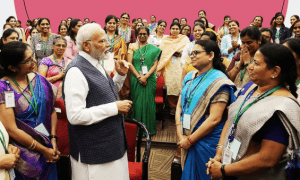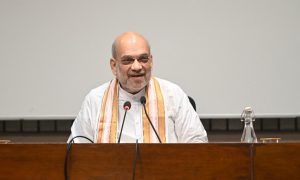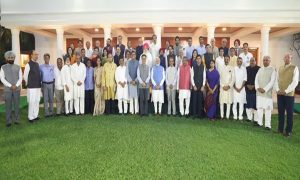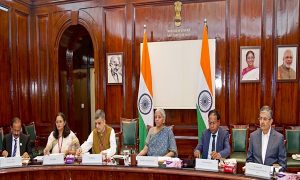The British considered India to be the ‘jewel of their crown’. And why wouldn’t it be?
India was a rich land laden with natural resources brimming with the enthusiasm of its huge populace. From towering mountains to tranquil beaches, from exquisite historic artefacts to nature’s dense forests…India had everything anyone could desire to rule over. The British did just that, ruthlessly I might add, crushing the Indian economy and at times even its will to think as one nation.
British rule is often glorified with arguments such as ‘if the British hadn’t come then India wouldn’t have had railways and roads and civil services’. What an arrogant assumption! Our civilisation is 5,000 years old and some of the most staggering marvels on the face of the Earth are on Indian soil in the form of temples and palaces. Engineers today, despite enjoying the luxuries of the most unthinkable of technologies, scratch their heads in wonderment about how Indians must have built their iconic structures. The Kedarnath Temple at a height of over 3,500 metres is one such glowing example.
If we could’ve done this, then I’m sure we could’ve managed rail and roads.
The problem with pro-British rhetoric is that it turns a blind eye to the horrific atrocities committed by the British in the name of ‘governance’ or that ‘Indians aren’t capable of ruling themselves hence we, the British, are needed’.
Some revealing facts:
•85 million Indians died from 1757 to 1947 due to violent and non-violent reasons
•India’s GDP contribution to the world when the British came was 23% which fell to below 4% when they left
•India accounted for 27% of world trade when the British came and this was squandering at below 2% when they left
Let us now review some of the policies of the British that ought to shake the foundation on which pro-British rhetoric is based.
‘The Famine Policy’. The British made deliberate use of famines and food control as a means to rule. From the beginning of the 11th century to the end of the 18th century there had occurred 14 major famines in India; that’s 2 per century. From 1756 to 1858 under the rule of the East India Company there were 16 famines. Under British Colonial rule from 1859 to 1914 there was a major famine every two years on average. This means in less than 2 centuries India was hit by over 40 famines! Due to these famines the population of India remained at about 220 million for over a century till 1914. The British deliberately created famines in selected regions so that the mass of starving people could then be used as slave labour for creating infrastructure.
‘Tax Farming’. Tax farming is basically ‘outsourcing’ the right to tax the land. This was the method adopted by the Company to increase its tax revenue. The tax collector had the right to obtain as much tax as he could as he had bought these rights at auctions. The one who was taxed – the zamindar – would then extract whatever he could for himself and the tax collector from the poor peasant who worked the land. The zamindar was subject only to the Company’s taxes and had complete power over the land and its cultivators. This allowed him to exploit the poor to extract maximum wealth. This looting system left nothing in the hands of the poor and no reserves for tough times when there was drought. Neither was anything invested in irrigation works; the poor were completely at the mercy of a good monsoon.
‘The Weapon of Usury’. As railroads grew at incredible rates, a class of money-lenders got created that acted as intermediaries of the British. This enabled the British to have effective control even on those areas not affected by famines. Prices of food in these famine-protected areas would rise multiple times as food was needed in other parts of the nation. These money-lenders then sold British goods to Indians in these areas at inflated prices and bought their grains at low prices. They would then sell the same grains at higher prices either in the international market or to the very same people during times of famine! Because of the high prices paid by Indians, these transactions were largely carried out on a credit basis leading to large sections of people becoming debt-slaves.
Data about the export of grains and rice supports the fact that the British deliberately created famines. Export of rice grew 1.45 times from 1867-68 to 1877-78; during the same period wheat exports grew 22 times (what needs to be remembered is that there was a major famine in 1876-78). So, instead of the food produced by Indians being used to fill Indian stomachs, it was exported during times of famines thus leading to tens of thousands of deaths.
The founder of modern China, Sun Yat-sen had written in 1917 about the rule of the British in India and I quote: ‘Every year, England takes large quantities of food stuffs for her own consumption from India, where in the last ten years, 19 million people have died of starvation. It must not be imagined for a moment that India is suffering from underproduction. The fact is that what India has produced for herself has been wrested away by England. Is that any better than submarine warfare? Nominally, of course, the British are not plundering, but in fact the exorbitant taxation and tyrannical rule in India are such as to make it impossible for the natives to maintain their livelihood; it is nothing but plunder on a grand scale.’
The British Raj wasn’t at all hunky-dory as often opined. It was silent ruthlessness on a humongous scale that involved purposeful killing of innocents and trampling of every moral and ethical right that a human deserves.




























 WhatsApp us
WhatsApp us